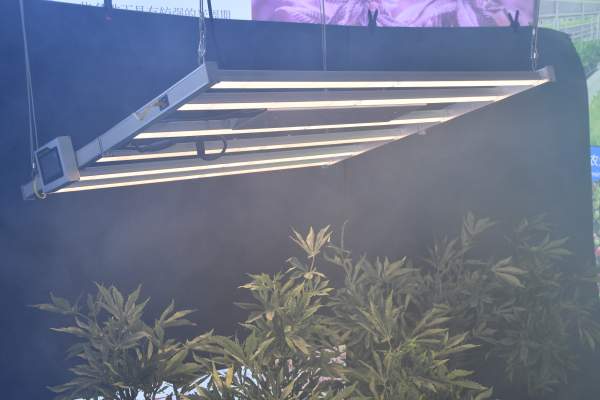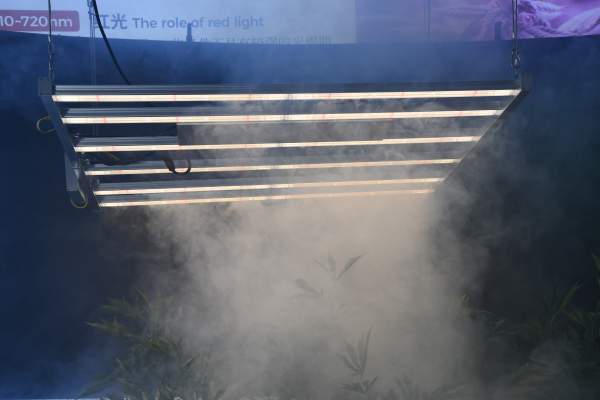Why is it a wise move to switch to LED plant growth lights
Deciding which grow light to use in your indoor garden is a major decision that will not only affect your potential harvest, but also the overall operating setup. There are two main types of indoor plant lights to choose from, high-pressure sodium (HPS) or light-emitting diode LED plant growth lights. The ongoing debate between the two very different lighting options is fierce, and experts are weighing them. As LED lighting companies continue to improve and improve their products, the tide is developing in a direction that is beneficial to them.
Why does it make more sense for indoor growers to switch to LED grow lights than ever before? The initial cost of LED grow lights has dropped significantly, the technology has been improved to make better use of light science, and manufacturers have also realized the energy-saving potential of LED grow lights.
Many indoor gardeners are cautious about the choice of LED grow lights because they have experienced old, outdated versions that were released long before many current innovations appeared. Today, even long-term growers have decided to switch from the HPS setting to the more technologically advanced LED grow light option; the arguments in favor of the LED grow light are becoming more and more convincing.
Electricity bill
Considering the scale of some indoor facilities in the ever-expanding indoor gardening market, electricity bills can easily become one of the highest expenditures. In a recent study, the statistics provided by the researchers showed that lighting consumes an average of 38% of the total energy use. This is what makes it the largest part of the company's energy costs.
Although LED grow lights have indeed experienced price declines in the past few years, their up-front costs are still considerable compared to traditional HPS systems. According to the research cited above, most LED plant growth lamps will recover their costs through energy saving alone within two to four years.
There is relatively little fair or well-implemented research on the full cost-saving potential of switching to LED plant growth lights. Do you include the cost savings from reducing the burden of ventilation and humidity? What should I do if the burden on the air conditioner is reduced? There are significant differences between the brands of LED grow lights. How do you compare these differences? Some growers try to perform mathematical calculations and estimate that within a year, after switching to LED plant growth lights, they can save 50% to 60% of energy costs.

Efficiency
The heat emitted by the lighting is one of the indicators of its efficiency. Based on the overall performance, about 80% of the energy of HPS and CFL is released in the form of heat, while LED plant lights only release 15% to 25% of their energy in the form of heat. Since LED grow lights use most of their energy to generate light, it is easier to avoid excessive heat that may be harmful to crops.
HPS and LED grow lights
Life span
If you are planning a long-term planting operation, the lifespan of a particular LED plant grow light is as important as its efficiency and upfront cost. HPS lasts about 10,000 hours on average, while led grow lights will run for about 50,000 hours. They need to be replaced every 2 years or less. The lifespan of LED grow lights is much longer than the above options because they can work for 50,000 or even 100,000 hours. Therefore, you can use them for 5 or 10 years before you need to replace them.
Increase room temperature
The surface temperature of HPS bulbs can reach 750 degrees. If you do not use expensive equipment for proper control, it may cause many problems, including short plants, sparse flowers, and rapid drying of the medium, resulting in loss of root quality, nutrient deficiency or toxicity, and even The whole crop failed. The LED grow lights run cool, in fact, no additional temperature control equipment is needed except for the internal circulation fan. Lower light temperature will result in a more maintainable growth environment in which your plants can thrive. A lower temperature can also save water and expensive nutrients that evaporate in a high-temperature room. Colder root zones will produce larger, healthier root balls, which will ultimately lead to higher yields. Lower temperatures will not harm the oil production of plants, and the high temperatures generated by HPS lighting can degrade oils, sometimes completely peeling them from the tops of fruits and flowers. Keeping the plant's natural flowering oil intact will result in better tasting and smelling of fruits and flowers.
Improvements in light science
Another main reason why LED grow lights have begun to occupy the market is that their quality has been greatly improved since the early days. HPS's argument has always been that the light intensity emitted by HPS is much higher than that of LED plant growth lights, so growers believe that the potential for yield is greater.
Although this is true for the old LED plant lights, there is a huge difference between today's high-quality LEDs and past LEDs. The innovation of LED technology does not pay too much attention to intensity (although this has been improved), but to the spectrum required at each stage of the plant's growth cycle.
HPS produces higher lumen output than most affordable LED models, but this situation is changing rapidly. The same is true for our understanding of which types of light plants need which types in their growth cycle. High-pressure sodium lamps emit orange, yellow, and red spectra, but scientists recently discovered that plants need more blue, red, and UVA in the two most important stages: nutrition and flowering. This research has been incorporated into new LED lighting models that specifically focus on the spectrum required for indoor gardening.
Problems to avoid when using LED grow lights
Many people around the world grow cannabis at home, whether for recreational or medical purposes. Although some of them do a good job and produce good products, for others, the effect is not very good. We will provide you with the most common precautions when using LED plant grow lights, so that you can grow healthy plants and avoid any unnecessary troubles. This information is very relevant for beginners.
1. Overheating
If the leaves closest to the light start to turn yellow, you know that the plant has absorbed too much heat. If some leaves start to curl, it may also indicate that the plant is too close to the light. Good ventilation usually helps to solve this problem. Experienced growers will install electric fans in the planting tents to help the plants dissipate faster.
2. Insufficient lighting
Planting areas of different sizes need to choose LED plant growth lights with different powers. Think about how many plants you have planted and how many LED plant growth lights you need for normal lighting. You should also know the brightness of the lamp you are using.
3. The distance between the lamp and the plant is wrong
Excessive or insufficient light may be due to the light being too close or too far away from the plant. There is no optimal standard for setting distance, but it is recommended to place the LED plant growth light at a distance of 12 to 18 inches from the plant, and adjust the appropriate distance according to the growth speed of the plant. It is also very important to turn the pots from time to time to prevent uneven light. Cause the plants to tilt too much.
4. Choose inferior products
Light is the most important factor in plant growth because it triggers the process of photosynthesis. If you use an ordinary incandescent lamp, you are unlikely to grow strong, healthy plants. Therefore, in order to get the best results, we recommend using full-spectrum LED plant growth lights. They are specially designed for this purpose and can provide lighting in the precise spectral range required by the factory.
5. Choose the wrong spectrum
In order to grow effectively, plants need different types of light at each growth stage. This is very easy to achieve with full-spectrum LED plant growth lights, but if you choose the wrong settings, the plant will not develop well. You should also consider the conditions of the room you are growing up in. When the plant is in the vegetative growth stage, the plant can benefit most from the blue spectrum. This means that if you set the light to emit light in the red spectrum, it will only hinder the growth of plants.

6. Improper use of lighting
You may forget to turn on these plant lights because you are too busy. Or forget to turn them off, which sounds trivial, but the wrong arrangement is likely to adversely affect the growth of plants. Cannabis requires about 18-24 hours of light during the vegetative phase and 12 hours of light during the flowering phase.
7. Don't protect and maintain LED lights
LED grow lights are your friend and important investment, so you need to store them in a safe place. They bring many benefits to the continuous development process, and a little maintenance and preparation can save you a lot of trouble.
8. Other factors
In fact, growing cannabis indoors saves us a lot of trouble, but in the process of plant growth, we still need to consider many factors such as room temperature, air circulation, soil, nutrients, plant genetics and so on. Be patient and caring for plants, and plants will give us unexpected rewards.
As LED plant growth light technology is developing in an increasingly intelligent way, the arguments in favor of HPS are rapidly dissolving. In addition to the brief argument presented here, there are other reasons for indoor growers to switch. Energy-saving lighting technology eliminates the heavy burden of heating and dehumidification systems, while LED plant growth lamps are usually integrated lamps, making their installation and management techniques easier. Experts predict that LED grow lights will soon be used in all most indoor planting operations.






